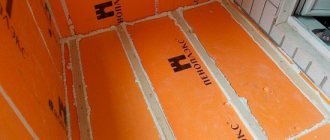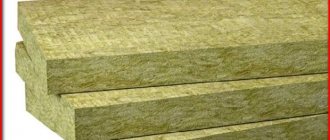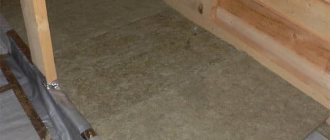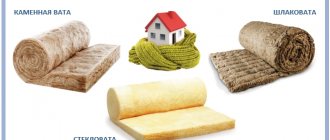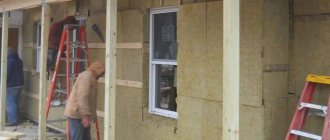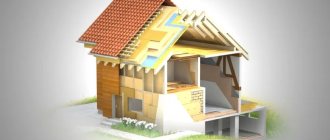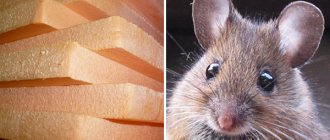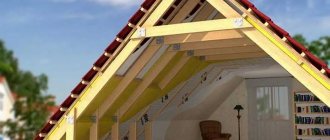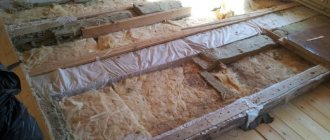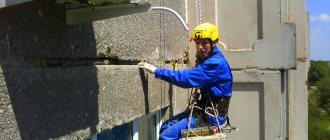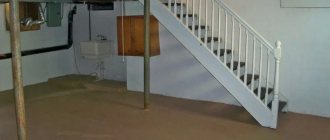In search of optimal insulation, more and more people are paying attention to rolled materials. With their help, you can achieve high-quality thermal insulation at minimal financial costs. In addition, you can install such insulation yourself without much effort.
One of the most popular roll insulators is basalt wool with foil. It is also available in slabs of varying hardness.
Foil insulation
General characteristics
The classic model of insulation assumes the presence of a porous structure that forms air chambers, which are an obstacle to the entry of cold air from the outside and the leakage of warm air from the inside.
1 - mineral wool, 2 - foamed polyethylene, 3 - expanded polystyrene, 4 - foamed concrete.
Products with foil work differently - a thin layer of aluminum reflects infrared waves, preventing heat from escaping from the room. The operation of a classic thermos is based on the same principle. Applying a thin layer of foil on a standard base allows you to achieve record heat saving rates - up to 99%.
Foil insulation is produced in the form of rolls, mats and separate sheets. Regardless of the basis, it has the following universal characteristics:
- not afraid of temperature changes and moisture;
- acts as a vapor barrier;
- reflected heat returns indoors by 95-99%;
- the foil coating prevents the base material from igniting in an open fire;
- The service life of foil-coated products is almost twice as long as their uncoated counterparts.
Features of foil material
The modern market offers a great variety of insulation materials for residential buildings. Fibrous materials have also found the widest application. And with the use of foil, which “works” by reflecting heat from its mirror coating, such insulation has the highest performance.
This heat insulator, which has a foil coating, is directly related to combined insulation materials. Its base - the base - plus a thin layer of polished aluminum foil reflects almost one hundred percent of the heat, with the base layer only absorbing about three percent.
Such an improved insulator keeps heat in the room for a very long time without releasing it outside.
Advantages and disadvantages
The advantages include:
- the service life of the material covered with foil increases from 25 to 75%;
- in addition to heat insulation, it demonstrates sound insulation properties;
- allows you to reduce heat loss, which leads to savings in money spent on heating the room;
- when using thermal protection with foil (maximum material thickness 5 mm), space in the house is saved;
- simple installation method and affordable price;
- light weight of the material.
Flaws:
- For thermal protection of external walls, foil insulation alone is often not enough - additional material has to be laid;
- the impossibility of pouring cement-sand mortar over the foil layer;
- the high cost of metallized tape, which is required to hold together individual pieces;
- To install thermal protection with foil on vertical surfaces, you have to purchase glue, which increases the estimated cost of the work.
Application area
Thermal insulation with foil is used in the following cases:
- if necessary, insulate water risers;
- to protect ventilation systems, wells and boreholes from cold outside air;
- to increase the reflectivity of the “warm floor”;
- to create a screen that is designed to reflect heat waves from a heating radiator or air heater;
- as a classic protection against cold outside air in country houses, bathhouses and other outbuildings.
Types of foil insulation
Products coated with foil are produced in the form of rolls, sheets, and also in cylindrical form for thermal protection of pipes.
The basis of reflective insulation is various materials: mineral and basalt wool, polyethylene foam and polystyrene foam.
Foil basalt wool
Basalt insulating mats covered with foil are considered an almost ideal material with no disadvantages, but their use in country and cottage construction is limited by financial capabilities. Available in the form of rolls, individual plates or cylinders with a locking lock.
Foil polyethylene foam
The most affordable and widespread heat-shielding material in construction is foil. Produced under the brands: “Izolon”, “Penofol”, “Folgoizol”. The technical characteristics of the material from different manufacturers are similar: reflection coefficient up to 97%, density from 26 to 45 kg/m3, thickness from 2 to 20 mm.
Products based on polyethylene foam are produced in rolls or individual slabs. Products are divided into several types:
- A – for internal use. The foil is applied only to the front side;
- B – for protecting roofs, external facades of buildings and pipelines. The foil layer is applied on both sides;
- C – self-adhesive material;
- R – similar to the first option, but with a decorated front side. Designed for outdoor installation;
- ALP - reflection coefficient - 99%, convenient for equipping utility rooms on a farm;
- NET – material for pipe insulation. Metallized coating is applied inside and outside;
- 200oC – self-adhesive material with a low adhesion coefficient.
A base made of uncross-linked polyethylene, unlike cross-linked polyethylene, does not recover its original shape after compression and shrinks over time.
Foil mineral wool
Applying a layer of foil to traditional mineral wool insulation made it possible to eliminate the main problems of this material - volume drawdown and poor moisture resistance. Foil-coated mineral wool is produced in rolls or individual mats with a thickness of 50 to 100 mm. The most famous brands: ISOVER, Knauf.
Foiled polystyrene foam
In the production of polystyrene foam insulation, two types of base are used:
- Styrofoam;
- extruded polystyrene foam.
Applying a foil layer to both materials equalizes their characteristics. In both the first and second options, the density of the material varies from 30 to 50 kg/m3, thickness - from 20 to 50 mm, and the reflection coefficient reaches 97%. The product based on polystyrene foam is not subject to rotting and does not react to high humidity and temperature fluctuations.
Thermal protection is made with slabs or strips of separate sheets fastened with fiberglass mesh. Most often, this material is used when assembling heated floors, so a wiring or pipe laying diagram is often drawn on the front side.
Where can I buy
The companies presented on our website sell a wide selection of basalt-based materials:
- basalt cardboard is sold by enterprises whose contact details are collected here;
- basalt slabs are sold by companies from this section;
- insulation materials are supplied by many companies, some are presented here;
- Cylinder shaped pipe insulation is offered by the following companies.
Popular brands and prices
Let's figure out what insulation with foil is called and how much it costs. Thermal protection with a polyethylene foam base is produced under the following brands:
- "Izolon". Cost from 80 to 120 rubles. per m2, depending on thickness (2-3 mm).
- "Penofol". Cost from 80 to 470 rubles. per m2, depending on thickness (3-20 mm).
- "Ecofol". Cost from 40 to 75 rubles. per m2, depending on thickness (2-12 mm).
Thermal protection with polystyrene foam is produced under the following brands:
- "Penoplex".
- "Knauf".
- "TechnoNIKOL".
Cost also varies by thickness. The price for this type of thermal protection is set per m3 and varies depending on the thickness and brand from 2,000 to 9,000 rubles.
Thermal protection with mineral wool is produced under the following brands:
- "ISOVER".
- "Rockwool"
- "Knauf".
The cheapest mats, 30 mm thick, can be purchased for 140 rubles. per m2.
Thermal protection mats made of basalt wool are produced under the following brands:
- "TechnoNIKOL".
- "PAROC".
- "Rockwool"
Cost from 5,000 to 15,000 rubles. per m3.
What insulation and why is it better to choose?
The appearance of foil on insulation led to the differentiation of its areas of application. Materials now have a narrow specialization.
Foil polyethylene foam
Foil-rolled polyethylene foam insulation in the class of reflective insulation has the widest range of applications. It is used for insulation:
- • floor. It is used as an additional thermal insulation layer in individual construction and the main one in apartments of multi-storey buildings. At the same time, it can simultaneously perform the functions of waterproofing materials. Insulation with a thickness of 2-3 mm is used as a substrate for parquet, laminate or linoleum floors;
- walls and ceilings. The material is especially in demand in conditions of limited space (balcony, loggia), since the small thickness of thermal insulation minimally “steals” the usable area;
For reference: More details about the problem of thick insulation for walls indoors can be found on the StroyGuru website in the work “Insulation for walls from inside a house or apartment.”
- roofs. Used alone or in combination with other types of insulation;
- baths At the same time, it performs two functions: heat and vapor barrier, protecting walls and ceilings from heat loss and waterlogging. But there are exceptions: they cannot be used in steam rooms and saunas, as they become deformed due to high temperatures.
Another area of application available only to this type of insulation is heat-reflecting screens behind heating devices: radiators, air heaters, infrared films located on the walls and ceiling. This measure allows you to save thermal resources, and in significant quantities.
Foiled polystyrene foam
The main task of foil foam is to direct the downward heat flows of all types of “warm floors” back into the room. It is not used for other purposes, although the instructions do not prohibit it. The reason is the prices. With almost the same effect, you can insulate the walls with polystyrene foam without foil, which will cost about two to three times less.
The use of foil polyethylene foam is not limited to construction. It can be found in agriculture (insulation of calf barns, incubators), automotive (insulation and sound insulation of passenger car interiors) and footwear (warm insoles) industries.
Foil glass wool (mineral wool)
Like foam plastic, foiled glass wool has a narrow specialization - it is the main type of insulation for baths (primarily steam rooms) and saunas, although nothing prevents you from insulating a roof or attic with wool and foil.
The high heat resistance (+300oC) of glass wool with a foil side has made it possible to increase the scope of its application. It is widely used for thermal insulation of boilers, boilers, and pipelines. At the same time, collapsible cylinders or half-cylinders of different sizes, both in length and diameter, are produced specifically for pipes.
Foil basalt wool
The excellent thermal insulation properties of basalt wool do not require a layer of foil when insulating residential premises. This type of insulation can only be afforded by consumers with unlimited financial capabilities. Therefore, foiled stone wool is used mainly for insulating buildings with a high level of fire danger (withstands up to +700oC), for example, gas stations. In this case, the external walls (facade) are insulated.
Insulation technology
When working with foil materials, you should adhere to a technology that is different from the methods of laying conventional thermal protection.
Which side to lay
Taking into account that the purpose of the foil layer is to reflect thermal waves, it becomes clear which side to lay the material on - the metallized side to the heat source . When installing mats on an outside wall, for example under siding, the foil should also face outward to prevent cold air masses from penetrating into the house.
Outside
To organize work on insulating external walls, you will need:
- Attach the slatted frame to the façade. The distance between adjacent slats should correspond to the width of the insulation minus 3-5 mm.
- The foil material is glued to the wall surface between the frame slats.
- After completing the insulation, it is necessary to cover the entire insulated surface with a reinforcing mesh.
- The final finishing with plaster, clapboard or siding is carried out using a fixed mesh.
From the inside
When installing the material indoors, the procedure is as follows:
- Vapor barrier material is attached to the walls using a furniture stapler.
- The next step is to fill the slatted frame, intended to form the base for finishing. The span between the slats should be 3-5 mm less than the width of the insulation.
- Insulation is glued into the resulting cells.
- The finishing finishing material is attached to the slatted frame, while a ventilation gap of 5 mm should remain between the inside of the finishing material and the thermal insulation.
Applications of insulation with foil
Foil thermal insulation can be used to insulate any surface.
Floor
Floor insulation technology differs in the type of finishing coating.
If you plan to pour a floating screed followed by laying laminate, linoleum or floorboards, first prepare the base (the floor slab is repaired and primed, waterproofing is laid). Then they begin to install the thermal insulation, which is fixed to the base with glue.
Penofol with a thickness of up to 3 mm is usually chosen as insulation for a floating screed. After gluing the joints with metallized tape, you need to put a reinforcing mesh on the floor. At the last stage, the screed is poured and the finishing coating is laid.
For heated floors, it is advisable to purchase ALP insulation with a thickness of 3 mm. The technology of work resembles the option with a floating screed, but after laying the thermal insulation, a heated floor system is installed on top of it, and only then the screed is poured.
Walls
To insulate vertical surfaces, roll-type foil insulation for walls is used. As a base, it is recommended to buy insulation with fiberglass or polyethylene foam.
On a surface leveled with sheet materials (gypsum plasterboard, OSB), the thermal insulation with foil is fixed with glue. If sheathing is prepared on the walls, the insulation is tightly placed in the cells. If, when laying foil insulation, there are gaps in the sheathing, they need to be closed with polyurethane foam. The joints of individual sheets are sealed with metallized tape.
After installing the insulation, the walls are finished with plasterboard or wood-based materials (plywood, OSB). To insulate walls, the following brands of insulation are used: “Izolon”, “Penofol”, “Ekofol”.
Roof
For thermal insulation of the roof, it is recommended to use foil roll insulation based on mineral fiber. In our country, owners of dachas and country houses are accustomed to inexpensive but high-quality brands - “ISOVER” and “TechnoNIKOL”. For wealthier consumers, we can recommend installing Rockwool and Knauf insulation.
The technology for installing insulation on the roof is as follows:
- on the inner roof covering, seal all cracks using tow or foam;
- the sheathing is prepared according to the size of the thermal insulation;
- the entire internal surface of the roof is covered with a rolled vapor barrier, which is secured with a stapler;
- to hold the installed insulation, horizontal strips are stuffed;
- The thermal insulation is tightly placed in the cells of the sheathing, and the joints are taped with metallized tape.
Ceiling
The name of the insulation with foil, which is recommended to be used for ceiling insulation, is “Izolon”. The thickness of such material should not exceed 5 mm. Self-adhesive foil insulation and material covered with foil on both sides are suitable.
Self-adhesive sheets should be attached directly to the leveled surface of the ceiling with additional fixation with glue and dowels with a large plastic cap. Double-sided foil material is attached with glue and dowels.
Drywall is mounted on top of the thermal insulation on metal guides and finishing work begins; if you plan to install a stretch ceiling, no additional finishing work is required.
Baths
For a bath, you should use insulation based on mineral wool, such as “ISOVER” or “Rockwool”. To better maintain the high temperature inside the steam room in a sauna or bathhouse, the ceiling and walls will have to be insulated. To prevent the penetration of moist vapors to wooden floors, the ceiling space is additionally insulated with parchment paper.
To install the insulation, you will need to install a sheathing, inside of which pieces of insulation will be inserted. The joints of individual strips are glued with metallized tape. After installing the insulation, a counter-lattice is attached on top of it, onto which the finishing is already fixed. The gap between the insulation and the lining is needed to create ventilation.
Installation features
Installing insulation is not always simple and requires certain conditions to be met. The levels of the “insulation pie” are as follows:
- The finishing itself is usually made from natural materials. Wooden lining is often used as an environmentally friendly material.
- Vapor barrier. This is a film (membrane) that protects against moisture and vapor. Its installation is carried out close to the finishing material.
- Ventilation gap. This is simply an air gap created by lathing.
- Foil insulation for walls. Laying is done so that the reflected rays return to the room in the direction of the main wall.
- Waterproofing. Also a membrane that does not allow moisture to pass through, but allows steam to pass through. Its installation is carried out close to the insulation.
- An air gap is required between the foil and the adjacent surface, and if this is not done, the insulation will not reflect infrared rays.
The heat insulator is always located between the sheathing guides, which are used as wooden beams, the thickness of which should be greater than the thickness of the insulation. This provides a ventilation gap between the finishing material and the surface of the foil.
The guide battens should be installed at a distance of 3 cm, less than the width of the insulation itself. As for waterproofing, it is attached to the wall without a gap with brackets. This is how, due to the difference between the thickness of the wool and the cells of the sheathing, the material is seated tightly, without additional fixation.
Afterwards, a vapor barrier is attached to the sheathing, and the finishing is laid on top of it.
Insulation of walls indoors
Insulation of indoor walls is done only in the most extreme cases, when there is simply no alternative. Both builders and manufacturers of all kinds of insulation materials are arguing everywhere about whether this can be done.
This solution is far from the best, and external insulation would still be a more effective and justified method.
However, it happens when the walls of an apartment, for example, cannot be insulated in any other way due to very poor access to them due to the architecture of the house. Another point is that the high-rise building is too high to financially prevent the owners from hiring industrial climbers, and therefore people take risks by insulating their homes from the inside. There is one more nuance that does not allow insulating the apartment from the outside - the house may be an architectural monument and its pristine appearance is jealously monitored by local authorities.
It's time to talk about the disadvantages of this solution:
- Shift of the so-called “dew point” inside the housing. As a result, the walls freeze to their entire thickness, and cold air at the junction of the wall and the insulator meets warm air - hence condensation. The consequences are the most unpleasant - fungus on a wet surface, reduced efficiency of the heat insulator, deterioration of the finish, etc.
- When a wall freezes, it loses its ability to accumulate heat. Control over the temperature in the room becomes more difficult - the air warms up faster from radiators and from sunlight, and very quickly loses temperature when ventilated.
- There is no 100% thermal insulation due to cold bridges at the intersection of external walls and partitions inside the home.
- Increased humidity inside the house. This, along with mold and mildew, is harmful to health. To achieve good heat exchange, you have to ventilate your home very often - this increases heating costs.
- To some extent, the usable area of the house is reduced, especially if a thick layer of insulation is installed in harsh climates.
- If the renovation of the premises has already been done, you have to do it again, which is very troublesome and expensive.
- Over time, condensation will destroy the walls and spoil the finish.
To some extent, calculating the required layer of insulation and choosing the right material partially saves the situation.
And yet, sometimes such insulation measures are unavoidable, and it is still possible to ensure dry walls by protecting the places where the dew point forms from the harmful effects of moisture.
Measures:
- Use of a high-quality multi-layer membrane to provide waterproofing. At the same time, it is necessary to lay it correctly - overlapping, sealing after the joints.
- Select insulation with low vapor penetration rates. And if the wall material has a higher value, then there will be no condensation, since the moisture will come out.
- The insulation must be attached close to the wall surface. This is achieved by applying glue not in a continuous layer, but in dots or paths (beacons).
- To ensure forced ventilation, you will need to install windows equipped with air exchange valves.
- An accurate calculation of the thickness of the insulator is necessary - a reference point to average parameters will not help here, because it is necessary to take into account all the characteristics of the material used, the premises and the climatic zone.
- It is imperative to treat the walls with an antiseptic, for example, a special primer. Further work should be carried out only after the walls have completely dried.
Insulation of walls outside
Insulating the walls of a house or apartment from the outside is completely justified. There is a high efficiency of insulation, low price (insulation from the inside is usually more complex and expensive), ease of installation.
A huge number of people choose this particular method for the reasons listed above.
Perhaps the clear leader in insulating walls outside is occupied by polystyrene foam, which has an affordable price and is easy to process and install.
Balcony insulation
Such an aspect as insulating the balcony is also important, because the microclimate in the apartment depends on it. This part of the apartment is insulated using foil insulation, which has a polyethylene base. It is foamed, and then aluminum foil is glued on. The thickness of the finished combined material can be no more than 10 mm.
The canvas plays the role of a damper, reinforcement and effectively prevents heat loss.
Many people know this material under another name - penofol. It can be produced single-sided or double-sided, and its surface can be either corrugated or smooth. Additional protection may also be provided - a polyethylene film - it is applied by lamination.
Insulating a balcony without additional insulation is ineffective. That is why penofol is alternated with mineral wool or polystyrene foam.
It is easier to finish with polystyrene foam, especially if you use special glue (foam).
Insulation scheme:
- The surface must be prepared before sticking the foam.
- Next, wooden blocks should be secured on top of these layers - the finishing will be attached to them.
- The resulting “pie” is sewn up with any finishing material - for this they use plaster, siding, block house, etc.
- You cannot lay penofol overlapping - the joints must be sealed using special aluminum tape.
- When insulating the floor, guides should be placed according to the level, and foam plastic should be placed between them. Penofol is spread on the guides.
Further, there are the following installation methods:
- The floor is installed on top of penofol.
- Another sheathing is installed (second level), and then the floors are laid.
Experts advise using the second option, because with the first it is impossible to obtain the ventilation gap necessary for reflection. If this is not done, then there is no point in using penofol, since it will be of no use.
Thermal insulation of pipes
Pipes no less need insulation, no matter where they pass - above or underground. Heat losses must be reduced to a minimum, and foil insulation is successfully used for this purpose.
It is even used inside unheated rooms, country buildings, in basements, etc.
In order to install foil heat insulators, you do not need to have any special knowledge and skills - any construction amateur can do this.
If the insulation is made in the form of a cylinder, then such installation is even simpler: after removing the protective film covering the adhesive layer, then you should connect both halves together - the cylinder consists of two longitudinal parts.
The reflective surface of the communications protects them from the sun, if the reflector is located on the outside, and if the coating is on the inside, then heat transfer occurs towards the pipe.
Some industrial communications should not be heated in the sun for safety reasons, so we can solve this issue with the help of foil insulation.
These materials can be used for interior decoration; in addition, they are successfully used outdoors. The basis of such insulators:
- Foamed polyethylene.
- Expanded polystyrene.
- Mineral (basalt) wool.
- Stone wool (a type of mineral wool).
- Metallized foam insulation.
Bath protection
To insulate baths, roll materials are often purchased - it is much easier for an unskilled worker to work with them. Foamed polyethylene or mineral wool of medium thickness are also used.
Most often, wooden buildings are insulated, starting work from the ceiling, then moving to the walls, and the floors are insulated with foil material last.
In addition to this insulation, for the work you will also need parchment - this is for the ceiling, and it is laid in tandem with mineral wool.
Wall insulation scheme:
- A wooden sheathing is made, on which the rolled material is laid.
- Then the planks are attached to the sheathing - they secure the material. Then the ceiling covering is attached to them.
If the insulation breaks, it is sealed with special metal tape.
The absence of basalt (mineral) wool is replaced with other foil materials, if they are already available. Installation is done the same way.
The easiest installation method is using polyethylene foam. In this case, the roll is cut into strips of the required size and the ceiling is insulated. The seams are glued together with heat-resistant tape.
They do the same with walls. The only difference is that a five-centimeter overlap is required - this must be taken into account when cutting material for the entire scope of work. This measure will not allow the steam to leave the premises.
A small gap should be left between the foil layer and the inner surface of the wall.
Since steam always rises, increased attention should be paid to ceiling insulation. Many bathhouse organizers lay basalt wool in two layers, considering this measure necessary, despite the financial costs.
Outside the building
Wooden houses also need insulation, and here the best option would be to do it from the inside. If this is not feasible, external insulation is also acceptable.
To accomplish this task, mineral wool with a thickness of 5 cm is used.
What you need to prepare for this:
- Glue.
- Dowels and a gun.
- Sanding brush.
Work should begin with the arrangement of a metal cornice, which is secured with dowels. This is required for the even placement of mineral wool slabs. Next, step by step:
- Glue is applied to the inside of the wool, and the slab is pressed against the wall surface. Plastic dowels serve as auxiliary fastening.
- Level the surface using the mentioned brush.
- A windproof film is laid on top of the insulating layer.
- Next comes priming, and after that comes external finishing.
When insulating a wooden house, it is necessary to use antiseptic compounds and the corners must be treated especially carefully.
External insulation can be done using perforated foam foam - it will protect the walls from getting wet. How it's done:
- A rack structure is being built, to which sheets of this insulation will then be attached.
- The joints are sealed with metallized tape.
Next comes the arrangement of the finishing layer.
Internal wall insulation
Internal insulation of wall surfaces can also be made with penofol - this is a universal material used for all types of insulation. The recommended layer is 5 mm.
If insulation is carried out in a cold climate zone, then this insulation alone will not be enough - another additional layer of mineral wool in rolls will be required.
How to install:
- The material is cut based on the height of the walls.
- Penofol is attached using a construction stapler.
- Upon completion of installation, the joints are sealed with tape.
- A plasterboard sheet (GKL) is laid on top of the insulator.
It is possible to replace penofol with foiled basalt wool.
For roofing
To insulate the roof, mineral wool, foil-coated basalt slabs, and penofol are often used. The latter cannot always solve the problem due to its small thickness, which may not be enough to achieve the required effect in severe winter conditions. Therefore, it is used in conjunction with mineral wool, for example.
